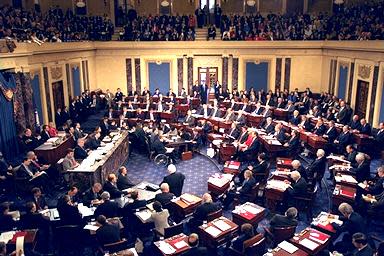Supreme Court limits, but also preserves, recess appointment powers
A unanimous Supreme Court said on Thursday that President Barack Obama couldn’t make recess appointments during a brief Senate break in 2012, but he also still had broad appointment powers under the Constitution.
In the short term, the decision could invalidate hundreds of decisions made by the National Labor Relations Board between January 2012 and August 2013. But it also reaffirms the President’s power to make appointments after the Senate officially says it is in a state of recess, and the ability of the Senate to define when it is in recess.
Link: Read the full opinion
“We thus hold that the Constitution empowers the President to fill any existing vacancy during any recess—intra-session or inter-session—of sufficient length,” said Justice Stephen Breyer, writing for the Court.
The ruling makes it clear that the President has the power to make a recess appointment for any opening that happens before or during a recess period. Opponents had argued that the President could only make recess appointments for a vacancy that happened during a recess period.
The case of National Labor Relations Board v. Noel Canning was heard in January 2014, soon after Senate Democrats eliminated the filibuster in some instances. The filibuster’s demise removed one impediment blocking President Obama’s federal appointments. But the Noel Canning case still left open some important questions to resolve.
Historically, recess appointments have been an important tool for the Executive Branch to circumvent the opposing party’s opposition to seating his nominees.
Article II, Section 2, of the Constitution gives the power to nominate “Officers of the United States,” in many instances subject to the approval of the Senate. However, the following clause also stipulates that the President has the power to “fill up all Vacancies that may happen during the Recess of the Senate.”
These appointments are temporary, expiring at the end of the next congressional session unless the Senate approves the nomination in the interim. Presidents of both parties have used recess appointments to circumvent the Senate in the event that the opposition party thwarted executive appointments through the filibuster or other tactics.
The National Labor Relations Board, or NLRB, is a body composed of five individuals charged with investigating and preventing unfair labor practices and adjudicating disputes between labor unions and companies. The NLRB requires a quorum of three members to issue decisions and orders.
During President Obama’s first term, Republicans in the Senate prevented the President from filling vacant seats on the NLRB, even going so far as to hold pro forma sessions, where often only a single lawmaker would gavel the body into session periodically over a break, often for a matter of only minutes.
When the number of members of the NLRB dipped to two, one below the needed quorum for the NLRB to render decisions, President Obama decided that despite the pro forma sessions, Congress was actually in the recess, thereby allowing him to make recess appointments.
In January 2012, while the Senate was out of town holding only pro forma sessions for a three-week period after beginning the 2012 legislative session, the President appointed three members to the NLRB, providing the body with a full membership and a quorum to be able to make decisions.
After beginning to issue decisions once more, the NLRB issued a ruling to settle a dispute involving a pay raise for union workers that had been agreed upon between Noel Canning, a company in Washington, and the Teamsters Local 760 union.
When the union alleged that Noel Canning had reneged on the agreement, the NLRB issued a ruling siding with the union, maintaining that Noel Canning had an obligation to abide by the terms of the agreement. Noel Canning then filed suit, arguing that because the Senate had been holding pro forma sessions when the President made the three recess appointments to the NLRB, the appointments were unconstitutional and the NLRB therefore lacked the authority to decide the case.
The issue of recess appointments has also become far less pressing since the Senate’s decision to eliminate the filibuster with respect to executive and judicial branch nominees (except for Supreme Court nominees).
So long as Democrats hold the majority in the Senate, President Obama’s nominees can no longer be obstructed by Republican filibusters, thereby eliminating the need for the president to use recess appointments as a means of circumventing the Senate.
If, however, Republicans wrest control of the Senate from the Democrats in the 2014 midterm elections, then President Obama would be unable to use recess appointments to fill vacant posts if Republicans prevented his nominees from being seated, in which case the Supreme Court’s decision in Noel Canning would impacts his ability to appoint federal officials to serve during the final two years of his presidency.
Recent Stories on Constitution Daily
Boehner’s lawsuit against Obama would face big hurdles
Podcast: Lead attorneys debate Supreme Court cellphone cases
Supreme Court issues historic ruling to protect your cellphone rights

